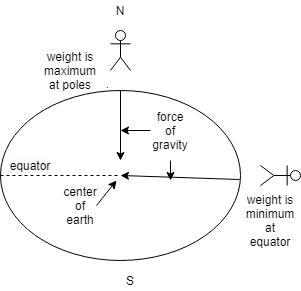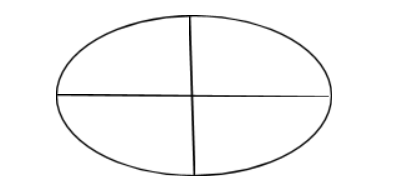
The value of acceleration due to gravity _____as we move from equator to pole.
A) Increases
B) Decreases
C) Remains the same
D) Become zero
Answer
498k+ views
3 likes
Hint: As we all know that earth is not a perfect sphere. It is actually an ellipse shape. The gravity kept on changing as we moved from one place to another. But it is maximum at the place where it is nearer to the center. The center of the earth lets be
Complete step by step answer:
Step 1:
The earth is not a perfect sphere. It is in an oval shape similar to the ellipse that’s why the gravity is not the same in each and every part of the earth. It is maximum at the place which is nearer to the center. So, the earth is kind of an ellipse and the equator is further away from the center of mass of the earth than at the poles. So, as we go from the equator to poles, the value of g increases.
Step 2:
In the SI unit the acceleration is measured as in
The weight of an object on earth’s surface is the downwards force on that object, given by Newton’s second law of motion,
The gravitational acceleration contributes to the total gravity and rotation of the earth also.
Step 3:
To understand we must know about the ellipse and also a diagram is given below for better understanding.

Here in the diagram, we can see that an actor or a man is standing in the equator and at the poles. Since the distance at the poles is smaller than that of the equator hence we can say that person has more acceleration due to gravity on the poles than the equator.
The value of acceleration due to gravity increases as we move from equator to pole. Therefore, option (A) is correct.
Note:
An ellipse is a plane curve surrounding two focal points such that for all points on the curve the sum of two distances to the focal points is a constant. As such it generalizes a circle, which is the special type of an ellipse in which the two focal points are the same.

Area of ellipse =
Complete step by step answer:
Step 1:
The earth is not a perfect sphere. It is in an oval shape similar to the ellipse that’s why the gravity is not the same in each and every part of the earth. It is maximum at the place which is nearer to the center. So, the earth is kind of an ellipse and the equator is further away from the center of mass of the earth than at the poles. So, as we go from the equator to poles, the value of g increases.
Step 2:
In the SI unit the acceleration is measured as in
The weight of an object on earth’s surface is the downwards force on that object, given by Newton’s second law of motion,
The gravitational acceleration contributes to the total gravity and rotation of the earth also.
Step 3:
To understand we must know about the ellipse and also a diagram is given below for better understanding.

Here in the diagram, we can see that an actor or a man is standing in the equator and at the poles. Since the distance at the poles is smaller than that of the equator hence we can say that person has more acceleration due to gravity on the poles than the equator.
The value of acceleration due to gravity increases as we move from equator to pole. Therefore, option (A) is correct.
Note:
An ellipse is a plane curve surrounding two focal points such that for all points on the curve the sum of two distances to the focal points is a constant. As such it generalizes a circle, which is the special type of an ellipse in which the two focal points are the same.

Area of ellipse =
Latest Vedantu courses for you
Grade 9 | CBSE | SCHOOL | English
Vedantu 9 CBSE Pro Course - (2025-26)
School Full course for CBSE students
₹37,300 per year
Recently Updated Pages
Master Class 11 Economics: Engaging Questions & Answers for Success

Master Class 11 Business Studies: Engaging Questions & Answers for Success

Master Class 11 Accountancy: Engaging Questions & Answers for Success

Master Class 11 English: Engaging Questions & Answers for Success

Master Class 11 Computer Science: Engaging Questions & Answers for Success

Master Class 11 Maths: Engaging Questions & Answers for Success

Trending doubts
1 ton equals to A 100 kg B 1000 kg C 10 kg D 10000 class 11 physics CBSE

1 Quintal is equal to a 110 kg b 10 kg c 100kg d 1000 class 11 physics CBSE

How much is 23 kg in pounds class 11 chemistry CBSE

Difference between physical and chemical change class 11 chemistry CBSE

Number of oneone functions from A to B where nA 4 and class 11 maths CBSE

What is the z value for a 90 95 and 99 percent confidence class 11 maths CBSE




